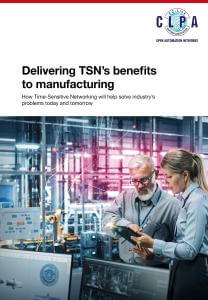According to the HMS industrial networking survey, over 70% of industrial networking nodes installed in 2023 were on industrial Ethernet. Yet, despite growing implementation of Time-Sensitive Networking (TSN) by mainstream suppliers, they still receive little mention. Why is that?
To start with, Time-Sensitive Networking is not just another variation of industrial Ethernet. Rather, it is a developing technology that makes standard Ethernet deterministic by default. TSN ensures precise control over the time data takes to travel across a network. This is critical for industrial applications and processes relying on real-time performance, such as robotics, automation, and machine control.
What is Time-Sensitive Networking (TSN)?
TSN is an extension of standard Ethernet designed to meet the needs of real-time communication in industries. Defined by the IEEE 802.1 working group, TSN builds on existing Ethernet technologies to enable predictable data flow across networks, ensuring low latency and high reliability. It aims to create a harmonised, protocol-agnostic industrial Ethernet network rather than adding to the Ethernet protocols already in use.
Interestingly, Wireless TSN (WTSN) is also suitable for deployment over Wi-Fi and 5G as a standalone network, potentially further expanding TSN’s reach and applications.
The Need for Convergence
An early expectation of TSN was its rapid adoption to drive convergence between Operational Technology (OT) and Information Technologies (IT). Convergence would allow all devices and systems to share the same physical network, simplifying operations and reducing costs. However, despite this promise, widespread adoption has not yet occurred. This may be due to stakeholder reluctance or a lack of clear understanding of the benefits of Time-Sensitive Networking.
Yet, as companies embrace digitalisation, they generate massive volumes of data from various technologies. The challenge becomes integrating disparate systems and networks to ensure seamless operations. TSN addresses this challenge by enabling converged networks that support both real-time and non-real-time traffic.
Furthermore, emerging technologies like Artificial Intelligence (AI) and Machine Learning (ML), which were once rare in manufacturing, now play a crucial role in process optimisation. AI needs large volumes of data to improve processes, and TSN supports the data handling needed to make that possible.
Why is TSN Needed?
Traditional Ethernet struggles to support both real-time and non-real-time data traffic, which can lead to performance bottlenecks and potential disruptions. Historically, various shop floor functions, such as real-time process signals, video inspections, and quality control data used different networks.
To manage these challenges, the leading control equipment suppliers developed proprietary solutions like Profinet, Ethernet/IP, and EtherCAT. However, these systems are not fully interoperable, resulting in complex and costly network architectures.
How TSN Solves These Challenges
TSN offers a solution by enabling converged network architectures to manage real-time and non-real-time data streams on the same infrastructure. Through precise traffic scheduling and prioritisation, TSN ensures the transmission of critical data without interference from other types of traffic. It achieves this without the overhead associated with proprietary Industrial Ethernet protocols.
Key features of TSN include:
- Real-Time Data Transmission – TSN ensures predictable and dependable data transfer, critical for applications like automation and robotics.
- Converged Networks – Combining multiple traffic types like motion control, safety, and video streams into a unified network, reducing complexity.
- Scalability for Future Technologies – Providing the network performance needed for emerging technologies like AI, ML, and IIoT.
- Enhanced Collaboration Between OT and IT – allowing seamless data sharing between OT and IT systems, enabling better decision-making and process optimisation.
The Benefits of TSN for Industrial Engineers
For engineers, TSN provides several key benefits:
- Simplified Network Architectures: By converging various traffic types into a single network, engineers no longer need to design and maintain separate infrastructures for different data streams, saving time and costs.
- Optimised Operations: TSN ensures the delivery of all data in real-time, enhancing process transparency and enabling better process optimisation and efficiency.
- Increased Uptime and Productivity: With fewer communication bottlenecks and system downtimes, TSN increases overall network reliability, leading to higher productivity.
- Future-Proof Infrastructure: TSN supports the integration of AI, machine learning, and predictive maintenance, making it a scalable solution for future technological advancements.
Preparing for the Future with TSN
As industries continue to evolve toward smart, connected factories, the need for robust, high-performance networks will only increase. TSN provides an Ethernet-agnostic foundation for the future, ensuring that companies can manage the growing data demands of modern industrial applications. In the future, proprietary networks like Profibus are likely to run over TSN on standard Ethernet, allowing industries to benefit from both.
For engineers, TSN offers a powerful tool to simplify network architectures, optimise operations, and prepare for the next wave of industrial innovations. By embracing TSN, companies can unlock the full potential of digitalisation and ensure they remain competitive in an increasingly complex market.
 In summary, TSN is key to unlocking the full potential of digital manufacturing by enabling converged, deterministic networks that support real-time data transmission. It helps engineers overcome modern industrial connectivity challenges while offering benefits such as simplified architectures, increased uptime, and scalability.
In summary, TSN is key to unlocking the full potential of digital manufacturing by enabling converged, deterministic networks that support real-time data transmission. It helps engineers overcome modern industrial connectivity challenges while offering benefits such as simplified architectures, increased uptime, and scalability.
As industries continue to evolve, TSN’s role simplifies the convergence of IT and OT. Further ensuring efficient, optimised, and future-proof operations will only become more critical. By adopting TSN, companies can ensure they are prepared for the challenges of both today and tomorrow, fully leveraging the advantages of Industry 4.0 and digital transformation.
Download a free copy of the CLPA white paper here `Delivering TSN’s benefits to manufacturing‘


